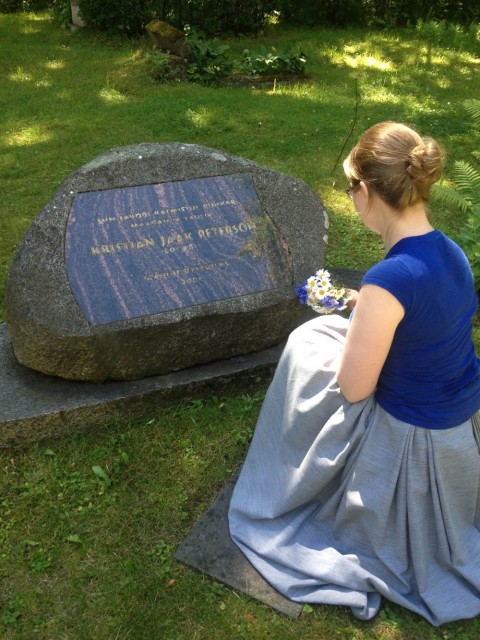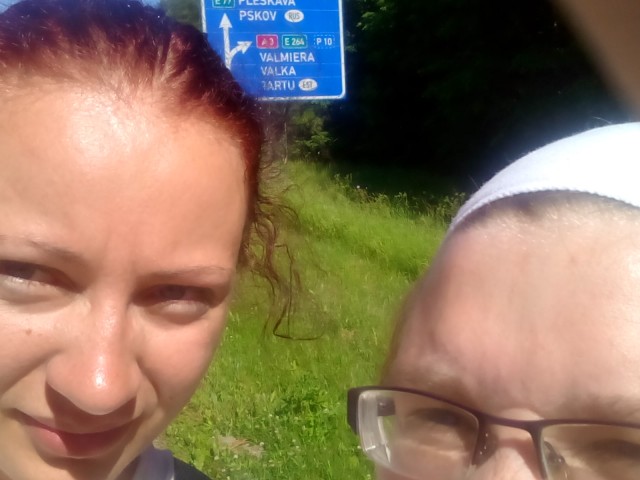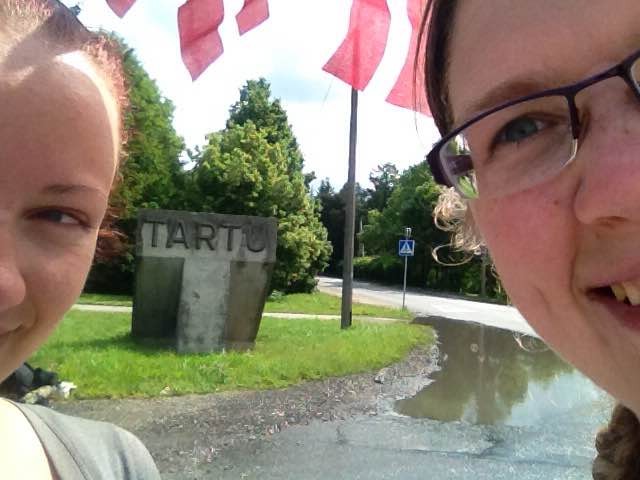Once upon a time, in the 19th century, there lived two young men. One of them was named Kristjan Jaak. He was an Estonian who was born in Riga and died in Riga, but in twenty-one years between those two occasions he managed to contribute so much to Estonian language that his birthday is now celebrated as Estonian Mother Tongue Day.
The other was Eduards. He was a Latvian who could not stand how wrong the socio-economic system of his time was, especially towards fellow Latvians; therefore, he wrote sceptical, pessimistic poetry and ended up studying law to help out the “little people” in general injustice.

Flowers for Kristjan — we got him “rukkililli” on our way to the graveyard. There was this old man in a completely random place where I have never seen anyone selling flowers in the Riga centre, and he had exactly what we needed — “rukkililled“. Photo from a personal archive
They lived a generation or two apart from each other, but both belonged to the academic family of Universitas Dorpatensis, each in his own time. I had already seen the monument to Kristjan on top of Toomemägi, when in one of my first Estonian lessons we were told that he actually walked from Riga to Tartu on foot to study. “An Estonian version of Eduards” was the first thought that crossed my mind, because even Latvians who have never read the poetry Eduards wrote tend to know that he too tended to walk the route and that for him education eventually turned out to be quite deadly. Literally.
Somehow this connection made me read more about both of them and the thought that I too could walk those two-hundred-and-something kilometres between Riga and Tartu became more and more insistent. After all, religious people make all kinds of pilgrimages for all kinds of reasons – why couldn’t academic people do it too? And what better destination for a Latvian student than the place where Latvians not only went to study but also built up the idea of Latvian-ness itself? After all, one of – if not the first – occasions when someone publicly declared that he considered him a “Latvian” was precisely in Tartu.
The more I fell in love with Estonia and Estonian culture through my weekly visits to Tartu, the more insistent the idea became, and eventually, somewhere in August 2014, I asked my fellow Estophile Lauma whether she would join me in such an adventure, mainly for the reason that alone I would not make it even to the departure point. She agreed without much hesitation.

Our anti-rain solution: Lauma is proudly wearing a cut-open 80 l plastic garbage bag; the construction is held together by safety pins and is very versatile. It beats any kind of those ready-to-wear raincoats as we tested. Photo from a personal archive
Almost a year later, two days before our actual departure, we decided it was time to meet and do some planning. Planning ended up to be looking at the map and repeatedly concluding with the phrase: “I guess we will see how fast we go”. Oh, and agreeing on some anti-conflict rules, such as: “It is allowed to complain about any kind of pain as much as you like” and “It is forbidden to be annoyed by the other person complaining about any kind of pain”.
On the next day, the evening before the start, we created a blog at which to note down some adventures if we would have the chance, and updated our Facebook statuses with something along the lines of: “If I do not respond as quickly as usual during the next two weeks, it is not because I don’t like you anymore”. Some of our shared acquaintances later said that that was the point when they figured out we were up to something big together.
As our starting point, we had chosen a building that had been a school back in the 19th century. It was quite a significant one, as both our literary friends, Kristjan Jaak and Eduards, had studied there. That is also where the first picture of our journey was made, something that was destined to become the first part of the series “the world’s worst selfies”. During the first days, we tried to improve our selfie-skills, but somewhere in the middle of the journey we gave up, and decided that “the object of interest framed by non-identifiable half faces” is our style, and went for it. We also took some normal photos. Just some, because usually we remembered that we had wanted to take photo of something ten or twenty kilometres later.

Our first day was also Lauma’s nameday, so we celebrated it with a “Buy all you can eat in the supermarket and then eat most of it in the wood next to it” activity. Still within Riga, but close to leaving it. Photo from a personal archive
Somewhere during the first day we also let our friends know about the blog. Up to that moment, two people knew exactly what we were going to do – our significant others. Some people, like our parents, knew we are going hiking, but not for how long or far. We kept it secret because we were not completely sure that we would even get started, and we did not want to risk having to find all kinds of excuses.
Now, when we had actually done our first kilometres, the blog had to take up quite an important function – to keep us motivated when the motivation faded. As we discussed, finding excuses for why we came back earlier would be even more unpleasant than why we did not go at all, so knowing that now other people knew what we were up to would help us keep going. The blog turned out to be quite a thing, but not as a motivator, because we somehow never lost the motivation, even when muscles and blisters were promising to kill us at least mentally and there were still a number of kilometres until the daily minimum.
Our first surprise was that people actually read it. The second surprise came when at one point we noticed that our friends shared the link to the blog via the University of Tartu and realized that our university had picked up this story. “Yeah, now we really have to finish”, we realized, because now the number of people who could potentially ask “Did you make it?” had increased significantly.
It was also quite fun at those moments when we would call our parents or grandparents to let them know we are still alive and to share some adventures over the phone and they, instead of listening would send us “to go and write the blog, because they want to know how we are doing”.
We also learnt that the wisdom that the fox taught the Little Prince, namely, “You are responsible for what you have tamed”, is true also in this case. When we lost Internet and could not update, people got worried where we were and why we were not writing. The hike that we initially thought would be completely disconnected from the digital rush became quite connected, and even ended up in national news, as the first story of the domestic news block.

The first time in our journey when we saw a sign saying we were going to Tartu. But as we took quite a detour to visit Kalāči, the real number was a bit (or a lot) bigger. This is how bad we are at the selfie-thing. Photo from a personal archive
Thus, we had started our eleven days of adventures that turned out to be eleven days of realizing how beautiful the two countries we crossed were, how wonderful the people living there, and how much joy and happiness we actually lose in our daily lives by not having enough time to notice the details.
Now, a month later and thinking rationally, my response to a journalist’s question about the favourite moment, something like: “Well, there was this sunset over the field of rye, and then right at my feet there was this snail crawling and trying to get to another leaf”, sounds silly. But that snail on that leaf with that sunset as the background, after ten days of being mostly just the two of us with the nature around us, really looked like a perfect embodiment of harmony.
The wild strawberries that we had to eat off the place we had chosen for building our tent pretty much every time, complemented that feeling of harmony daily. When we walked along the railroad, the initial feeling of nothingness turned into a feeling of being part of the never-ending story – as far as we could see, there was a way to go, in front of us and behind us.

Eduards’ sauna. Not only did we have a wonderful tour around the museum itself, hosted by my friend who grew up there, but we were allowed to take an afternoon nap in that little building. It still had that scent of dried herbs, water on the rocks, and buzzing fire. Photo from a personal archive
Our journey was shaped a lot by our two literary friends (kind of an upgraded version of “imaginary friends” children sometimes have, just with the twist that we know they were real two hundred years ago and not today). We did not walk the shortest route because we wanted to visit places significant to them, like the graveyard where Kristjan is buried or Eduards’ brother’s farmstead, where he lived when not at school or university. We even realized we could still quote some of their poetry learnt at school and at some point realized ourselves doing that. We tried to guess how much our route coincided with the routes they took or how similar the journeys were.
It is not out of disrespect towards those two great minds that we now refer to them by their first names only. At the beginning we actually used their surnames only. However, along the way they were very present in our minds all the time, as was the thought of them having been students like us, but actually even younger than us, and we put down all the images we had of them from our lessons and lectures in all kinds of schools and created our own very bright, very inspiring, flawed in one way or another, but still friendly human beings (who, by the way, both look better in their monuments than they do in the pictures).
Then we kept reminding ourselves that our academic pilgrimage was our choice and was more of an entertainment, whereas they had to walk if they wanted to study, and for some reason there was no horse or train to use for transportation. And stories have it that they spent less time on the way than we did.
Unfortunately for us, unlike in the 19th century, the system where every third major crossroads or so would have a tavern with food and a room is clearly gone, so even when it was raining (but mostly it was not) we were outside with our mobile two-person residence, called also a tent. Credible sources say that both our literary friends knew how to make use of taverns. Sources even say that one time a visit to a tavern saved Eduards from committing suicide. He later wrote a poem about that visit.

There was this kind shopkeeper who did not mind us accompanying him for the last hour of his working day by simply sitting around, warming up and getting dry after our first rainy-day walk. he let us charge our phones as well, and his wife suggested an excellent place for setting up the tent that evening. Photo from a personal archive
But even with no taverns we still met people – drivers who would stop by or even turn around, come back and then stop by to ask whether we needed a lift. A driver who, having learnt that instead of a lift we would appreciate some water, went to the nearest petrol station and brought us some. Or a librarian who not only stayed two hours over her working time because she saw we needed some rest, but also prepared a bowl of cold water and towels for our tired feet, and fed us all the chocolate that thankful readers had brought her earlier. Or the Belarusian shopkeeper in Estonia who insisted on speaking in Estonian, not Russian, and let us into her personal home kitchen to refill our water bottles.

That’s where we got the Internet, cold water for our feet, tea and chocolate, and got to tell everything because they wanted to hear everything. Photo from a personal archive
Or friends who not only read the blog, but treated us with a delicious pizza 50 km before Tartu because they thought we might appreciate it. Or the Estonian journalist who, having interviewed us for his article on day before our big finish, came to greet us at the finish line too, just because he wanted to greet us. Or the poet who left his fans and his book booth to come up the hill and recite us one of Eduards’ poems both in Latvian and Estonian. To name and describe everything would mean to rewrite the blog, extending it to something novel-like, but it still would not represent even half of it.
Eventually, we reached Tartu and did the last of world’s worst selfies at its stone sign. Then we also reached our true destination – the monument of Kristjan – but before that paying a short visit also to the place just down the hill where there was once a building that Eduards resided at for some of his study time. We went down to Raekoja plats for a meal that was not bread and canned fish and some real coffee, and somehow it felt different than before.
Even the main building of the university felt different – more appreciated, I guess. Because one thing is to know that there were Latvians (Eduards was far from being the only one) in the 19th century so willing to study that they were ready to walk to Tartu, and that some of them later laid the ideological foundations for what eventually became the independent Latvia, and another is to walk the path, feel the journey, and at the end of it realize that not only the journey itself, but also the reason for making it was shared with those great minds, and that it can be expressed in one simple sentence: I am a student of the University of Tartu.
Ilze Borodkina is a PhD student of Media and Communication at the University of Tartu.






















